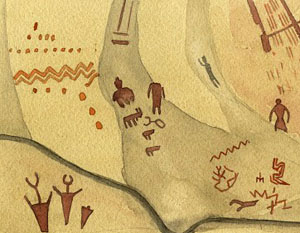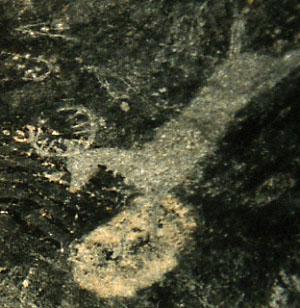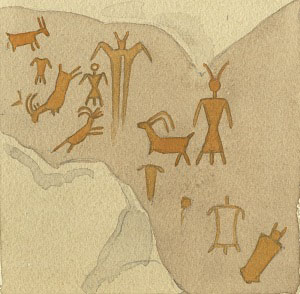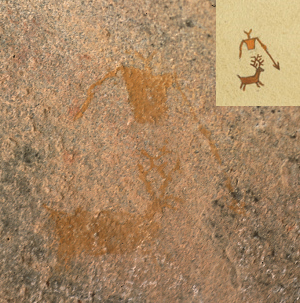Rock Art of Archaic Hunters and Gatherers
Archaic hunters and gatherers visited Hueco Tanks periodically over some 10,000 years, yet their contribution to the rock art at the site is relatively small, compared to the prolific artists of the Jornada Mogollon culture and later Historic period groups. Archaic artists left a puzzling array of abstract designs, including rectangular and curvilinear designs as well as parallel lines painted in zig zags. As shown in the photograph above, some linear designs resemble tines of rakes or combs. These geometric expressions, executed mostly in red and black, are thought to be among the earliest at the park. Representations of animals, particularly deer and mountain sheep, were painted in red and black as well as yellow, and may be related to shamanic rituals and ceremonies associated with animal “power.” The few humanlike, or anthropomorphic, figures attributed to artists of this period are depicted with bodies in hour glass or triangular shape, long thin arms, and small to non-existent heads topped by two “antennae”-like extensions perhaps representing feathers, horns, or headresses. In some figures, body parts are replaced by projectile points: One figure is shown with a long thin arm terminating in a dart point. Depictions of hunters with body parts resembling dart or spear points have been found at other rock art sites in the Trans Pecos. At Alamo Canyon near Fort Hancock, the elaborate hunting scenes are filled with anthropomorphs, animals, and spears or darts. Some researchers have interpreted the stemmed and heavily barbed dart points frequently shown as Shumla points, a style of dart point common in Late Archaic sites. Archeologist and rock art researcher Solveig Turpin, however, believes that that interpretation is too narrowly drawn, and that the point so frequently depicted is more of an "archetypal" dart point. For Archaic peoples, who relied heavily upon animals for subsistence, it seems natural that hunting scenes would be prominent in their artistic expressions and may have served as a storytelling device. Many researchers, however, have argued that the scenes are not literal recreations of past events but, instead, relicts of "vision quests" or rituals. The act of killing depicted in the scene may have been a metaphor for entering a trance-like state where the animal serves as spirit guide, or, the maker becomes the animal. As anthropologist Kay Sutherland noted in her study of the Hueco Tanks art, “The association of hunter and spearpoint implies a strong spiritual relationship between the hunter and the killed,” a transformation of the animal’s spirit to the hunter, and the hunter’s kill into food for the group.The spiritual processes represented may have been facilitated by a shaman or spiritual leader of the group, who accessed the animal world in dream or trance states. The powerful symbolism of transcendence, or metamorphosis from death to life, was probably the focus of Archaic religions. "Both the skilled hunter and the skilled shaman faced the possibility of 'dying' in order that others might live," Sutherland noted. "The hunter faced the possiblity of death in order to kill, and the shaman's body died (went into trance) so that the animal spirit could be brought to the group." Additional depictions of Archaic art in the Trans-Pecos region are shown in the Alamo Canyon section. Also see Rock Art of the Lower Pecos for very different Archaic styles.
|
|



